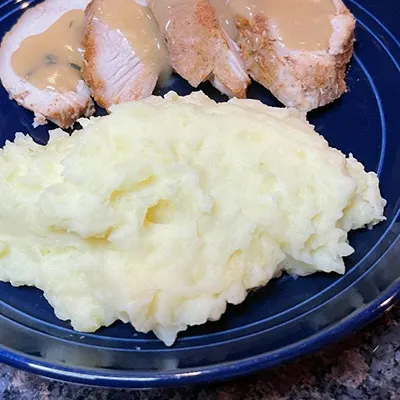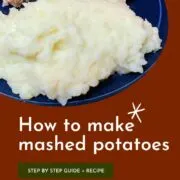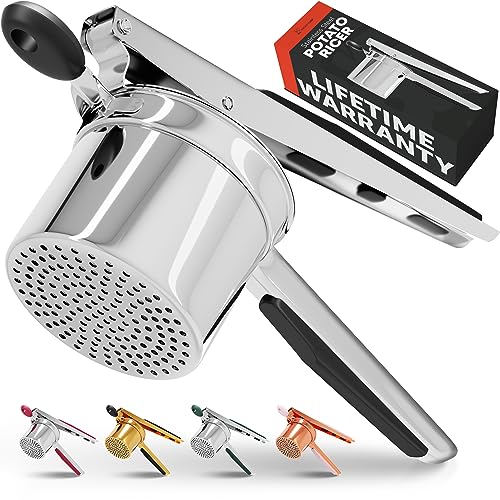This is a guide to making mashed potatoes that includes a recipe for garlic mashed potatoes.
Everyone loves mashed potatoes, right? They’re the ultimate comfort food plus a mainstay of holiday meals.
The thing is, there are tons of mashed potatoes recipes out in the world. Tons. But you don’t really need them. You can learn to make mashed potatoes without instructions. Master that skill and then you can have fun experimenting with different variations — from mix-ins to changing up the potato or the way you cook it.
Consider this the beginning of your mashed potatoes mastery. This guide covers the different types of potatoes used in mashed potatoes, various methods for making them, tips for achieving the perfect texture, fun ways to elevate your flavors, and how to reheat leftover mashed potatoes later.
How to make mashed potatoes

Every mashed potato recipe follows a similar set of steps. Here are the steps and you’ll find more info on each one in the later sections:
- Choose a type of potato
- Cook the potatoes
- Add liquid
- Mash
- Optionally, stir in flavor boosters like garlic, cheese, or bacon
- Optionally, bake (for twice-baked mashed potatoes)
- Enjoy
- Reheat and eat again the next day
1. Type of potato
Starchy potato varieties deliver a fluffier, creamier texture thanks to a low moisture content and more starch. Far and away, Russet potatoes — aka Idaho potatoes — are the first choice as they consistently produce the best mashed potatoes. Purple potatoes also have high starch, but your dinner guests may be surprised by the color.
Yukon Gold potatoes are less starchy than Russets, but they can still produce a nice mash.

Red potatoes, new potatoes, and fingerlings are better suited for boiling and roasting. That’s not to say you can’t mash them — I have. Just know that the texture will be a touch different.
2. Cooking the potatoes
Boiling is the most common method to cook potatoes that you plan to mash. You’d start by peeling your Russet potatoes and cutting them into even chunks. Place them in a large pot with cold water and add a nice pinch of salt. Turn on the flame and bring the water to a boil. Reduce heat and simmer until the potato chunks are tender — you can test them gently with a fork. This usually takes 15 to 20 minutes, but could be longer or shorter, depending on the size of your potato pieces.
Other ways to cook potatoes for mashing include steaming, baking, microwaving, pressure cooking, or smoking.
Steaming helps retain more of the potato’s natural flavor and nutrients. Peel and chunk the potatoes and place them in a steamer basket over boiling water until they are tender.
Baking is a hands-free option. Wrap the potatoes in foil and bake them until they’re soft. Let them cool slightly, then scoop the flesh out with a spoon.
Microwaving works when you’re short on time. I have found the texture of microwaved potatoes to be a little off, so this isn’t a method I’d recommend. Peel and dice the potatoes and microwave them at short intervals until they’re soft.
Pressure cooking saves time without giving you that microwave texture. Instant pot mashed potatoes have their own cult following, too. Peel and dice the potatoes, place them in the pressure cooker, and cover them with water. Pressure cook for 8 to 10 minutes and then do a quick release to check for doneness.
Smoking your potatoes delivers a nice flavor upgrade. Many of the smoked mashed potatoes recipes you’ll see online will tell you to boil the potatoes, mash them, add your mix-ins, and then smoke. I personally like the smoke the potatoes first. Wash them, pierce them with a fork, wipe on some olive oil, and smoke them for a couple hours at 225°F or 107°C.
3. Add liquid
The added liquid provides the creaminess you expect from mashed potatoes. Often, milk is the liquid of choice. You can use skim milk to whole milk, depending on your dietary needs. You can also use sour cream or butter — or a combination of the above. Or, if you prefer a non-dairy option, try an unflavored/unsweetened almond milk, any type of broth, or some of the cooking liquid if you boiled the potatoes.
Pro tip: Don’t pour cold milk into your potatoes. Heat it slightly in the microwave to match the temperature of the potatoes.
You probably don’t need a measurement here. Add a bit, mash, add more liquid, and repeat until your potatoes have the texture you want.
4. Mash
Your method of mashing can make or break the texture of your potatoes. You’re not striving for silky smooth potatoes — mostly because that’s unrealistic for homemade mashed potatoes (that weren’t reconstituted from a powder). If you keep mashing and mashing or get aggressive with a hand-mixer, your potatoes will get sticky or gluey.
So shoot for a textured mash. And use a gentle tool like a potato masher, ricer, or fork.
5. Flavor enhancers

Mashed potatoes are super versatile, so you can have fun customizing your dish with interesting flavor enhances. Ideas include:
- Garlic, fresh or roasted
- Chives, parsley, thyme, rosemary, or dill, fresh or dried
- Cheese — it’s hard to go wrong here, so choose whatever cheese variety you love, from cream cheese to Gruyere
- Bacon
- Caramelized onions or shallots
- Lemon zest
- Pesto
6. Twice-baking
If you like a twice-baked potato, you’ll use a bit of extra liquid in Step 3 above. Then scoop your potatoes into a baking dish, cover with more cheese if you want, and bake them until bubbly in the oven. You could also use your smoker for the second baking.
7. Enjoy
Mashed potatoes are usually served as a side dish, maybe with some gravy or melted butter. But you could easily turn your potatoes into a main course. For example:
- Bake the potatoes to cook them, scoop out the flesh and mash them. Add whatever ingredients you’d like plus a protein like leftover grilled steak or rotisserie chicken. Stuff the mashed potatoes back into the baked skins and serve.
- Twice-baked potatoes with bacon or ham plus cheese are rich enough to stand on their own as a main dish.
Tips for texture
These strategies will help you achieve the best homemade mashed potatoes possible:
- Cut the potatoes into evenly sized cubes when boiling
- Remove the potatoes from the simmering water as soon as they are tender (so, don’t overcook them)
- Warm the ingredients before you add them into the potatoes
- Use butter and sour cream or whole milk for extra creaminess
- Mash the potatoes while they’re hot
- Mash gently with a ricer
- Warm the serving bowl so the potatoes hold their temperature
For more tips, see:
- How long to cook potatoes for mashed potatoes
- Substitute for butter in mashed potatoes
- Substitute for milk in mashed potatoes
Reheating mashed potatoes
To reheat leftover mashed potatoes, place them in a saucepan over low heat, adding a splash of milk or cream to revive their creamy texture and prevent them from drying out. Stir gently over the heat and add more liquid as needed until they reach the right temperature.
Note that you can make mashed potatoes ahead of time and then reheat them later for serving. Simply place your prepared potatoes in a baking dish, cover it tightly with foil, and refrigerate. Then take the dish out of the refrigerator and let it sit at room temperature for 30 minutes. Let your oven temperature to 325°F or 163° and heat the dish until the potatoes reach the right temperature. Keep an eye on the moisture content and add milk as needed.
Garlic mashed potatoes recipe
This recipe goes very well with slow cooker turkey breast. To pair them together, you can skip the garlic roasting step below, as you can use the head of garlic that goes into the slow cooker for the turkey.
Garlic Mashed Potatoes Recipe

This is a simple recipe for garlic mashed potatoes. For plain mashed potatoes, you can omit the garlic.
Ingredients
- 2 lbs potatoes (Russet or Yukon Gold)
- 1 head garlic
- 1 tablespoon olive oil
- 1⁄4 cup sour cream
- 4 tablespoons butter
- Milk or cream, if needed
- Salt
- White pepper
Instructions
- Preheat your oven to 350°F or 180°C.
- Set a head of garlic on a cutting board on its flattest side. Turn it sideways and slice through the head so that you're cutting it's top off. The cloves inside should be slightly exposed. Set the head on a piece of foil large enough to wrap the head. Drizzle olive oil over the exposed cloves and wrap up the foil.
- Bake the head of garlic in the hot oven for 45 minutes. Remove it and let it cool slightly.
- Set out the butter and sour cream.
- While the garlic roasts, peel the potatoes and cut them into evenly sized chunks. Place them into a pot and cover them with cold water. Add a big dash of salt.
- Bring the water to a boil, then reduce the heat to simmer. After 15 minutes, gently poke a potato with a fork to check for doneness. If it's tender, scoop out 1/2 cup of the cooking liquid and set aside. Drain the potatoes and place them in a bowl.
- Pull the cloves off the garlic head and squeeze the roasted garlic into the bowl with the potatoes. Add the sour cream, softened butter, and a dash of white pepper.
- Mash the potato mixture with a fork, ricer, or masher until the ingredients are combined. If the potatoes seem too dry, add cooking liquid or warmed milk.
- Transfer the potatoes to a warmed serving bowl and enjoy.
Recommended Products
As an Amazon Associate and member of other affiliate programs, I earn from qualifying purchases.
Nutrition Information:
Yield:
4Serving Size:
1Amount Per Serving: Calories: 440Total Fat: 22gSaturated Fat: 12gTrans Fat: 1gUnsaturated Fat: 8gCholesterol: 52mgSodium: 296mgCarbohydrates: 55gFiber: 5gSugar: 7gProtein: 9g
Nutrition information isn’t always accurate.


Bobby
Sunday 19th of July 2009
Ernst - That is dried parsley.
Ernst
Sunday 19th of July 2009
I am a total cooking retard, but your website is helping me a lot, so thanks!
Now.. what's the green stuff on the finished picture?
Thanks
dollface
Tuesday 18th of November 2008
I've tried your recipe, its turn out nice & smooth..Very delicious..My hubby love this..Thanks for sharing this recipe!
Bobby
Monday 23rd of June 2008
zrinka_cro - Great, let me know how it turns out!
zrinka_cro
Monday 23rd of June 2008
Hey, thank you for this recipe...i will try it for sure. :))